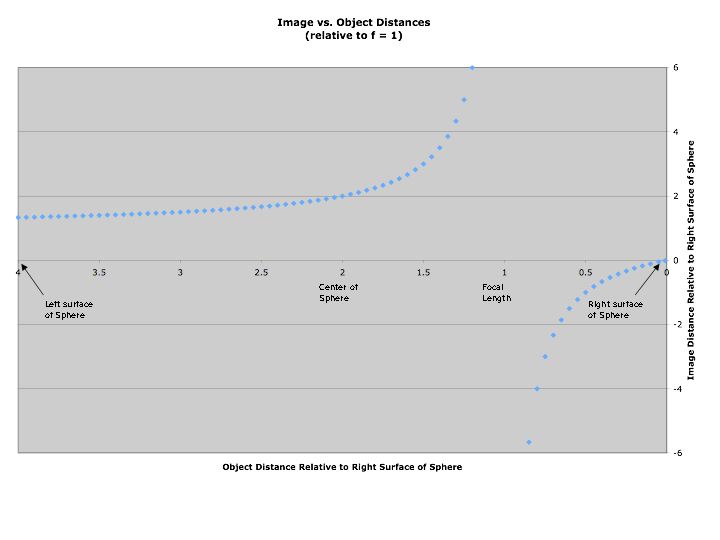Date: Wed Dec 14 18:36:53 2005
Posted By: John Link, Senior Staff Physicist
Area of science: Physics
ID: 1132694125.Ph
Message:
It's simply a matter of considering the inside surface of the sphere as a
concave mirror. Please read through the entire
Lesson 3 of the page referenced in this URL.
There is a major constraint in the problem that you propose: Neither
the observor nor the object can be farther than 2R from the central
reflection point (Point "A" in the drawing of the referenced URL.), for a
sphere of radius R, because both are inside the sphere! Let's divide the
problem into three areas:
1) The object is in the space between do = "almost zero" and
do = f.
2) The object is in the space between do = f and
do = R.
3) The object is in the space between do = R and
do = 2R.
We will use the "mirror equation" found
here.
Case 1: If do = "almost zero" then di = negative
"almost zero". If do = 1.0 (= f) then di = negative
infinity, which means that the rays of light are collimated. Between these
two limits the image distance is negative, meaning that it is a virtual
image outside the sphere (to the right of the right surface), and our eye
sees an upright virtual image, "behind" the surface of the mirror (outside
the sphere). The perceived size of the image goes from the same size as
the object to HUGE.
Case 2: If do = f then di = positive infinity,
which means that the rays of light are collimated. If do = R
(the object is at the center of the sphere) then di = R. The
image, except for where do = f, is an inverted (upsidedown) real
image, and our eye can focus the image if our eye is sufficiently far away
from the image. "Sufficiently far" depends on each person's eyes, with
normal young eyes being able to be accommodate (focus) for smaller
distances than normal old eyes (which have lenses that practically do not
focus).
Case 3: If do = R then di = R. If do
= 2R then di = 4/3. The image is inverted (upsidedown) and
real, and our eye can focus the image if our eye is sufficiently far away
from the image. "Sufficiently far" depends on each person's eyes, with
normal young eyes being able to be accommodate (focus) for smaller
distances than normal old eyes (which have lenses that practically do not
focus).
Applying the "mirror equation" to an Excel spreadsheet produces the
following graph:

Notice several things, which have already been mentioned, at least in
part, above:
1) As mentioned above, as the object distance gets close to the focal
length the image distance approaches negative infinity. Because the image
is virtual it can be "farther away" than the physical surface of the sphere.
2) When the object distance is greater than the focal length the image
distance decreases from positive infinity down to 1.333. But the image
distance is limited by the surface of the sphere, so di can not
be any greater than 4.0 without reflecting again from the mirror. See part
3) below. The limit of 1.333 is because the object can not be outside the
sphere and so do is limited to 4.0.
3) With the object distance between 1.0 (f) and 1.333, the image
distance is greater than the opposite surface of the sphere (di
> 4). In that case we can calculate the secondary image. For instance, if
the object is at 1.25 then the image distance is 5.0; this puts the image
at -1.0 with respect to the left surface, meaning that the secondary
"object" has a distance of -1.0. Putting that into the equation gives us
di = 0.5, so the final image is observable if we could turn
around and look the other way without our head getting in the way!
You can work with the equation to work out other situations. Have fun!
John Link, MadSci Physicist
Current Queue |
Current Queue for Physics |
Physics archives
Try the links in the MadSci Library for more information on Physics.
MadSci Home | Information |
Search |
Random Knowledge Generator |
MadSci Archives |
Mad Library | MAD Labs |
MAD FAQs |
Ask a ? |
Join Us! |
Help Support MadSci
MadSci Network,
webadmin@madsci.org
© 1995-2005. All rights reserved.
